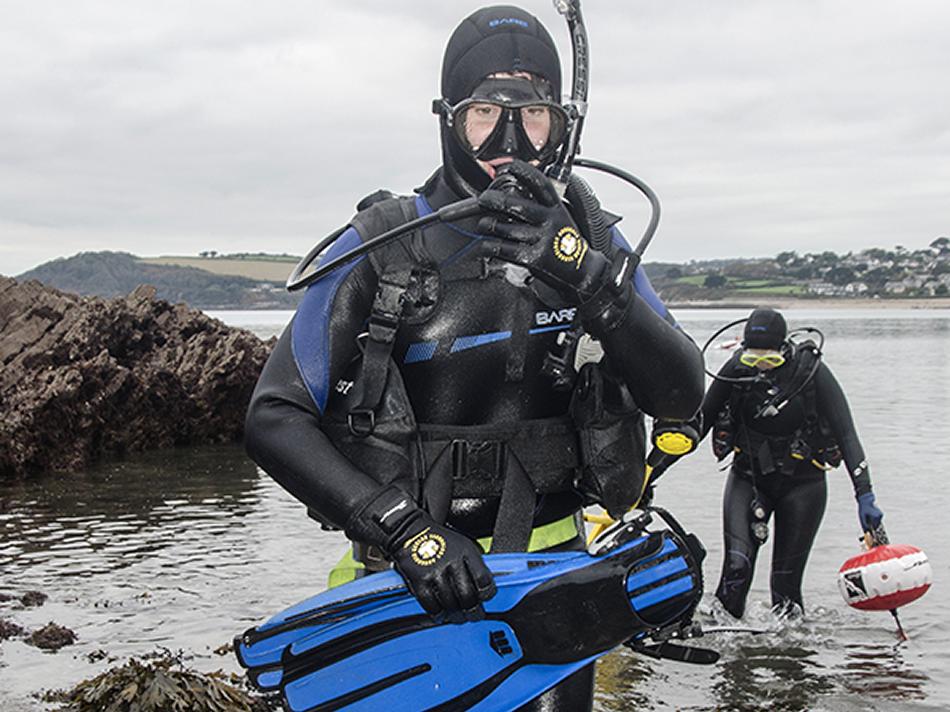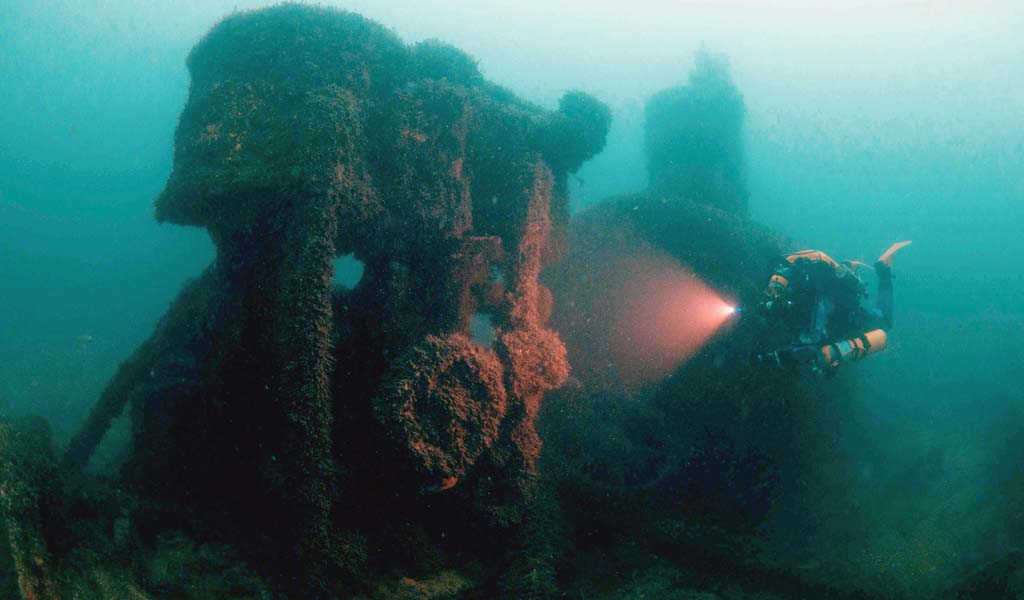
Johno and Cathy de Lara of Newbury BSAC have found much to see by going that little bit deeper off the south coast. Here are the first five of their top 10 wrecks in trimix range.
Learning the skills to dive to deeper depths, with longer run times, brings the benefit of increasing the number of wrecks that you can dive. Deeper, less dived wrecks might not have been identified until recently and even then only by careful examination of their stories, cargoes and engine / boiler configurations. This information, combined with good quality photos and video, is something that often only divers can provide.
In this two-part article, we are able to explore 10 wrecks in the English Channel in the 40 to 65-metre range. They are all trimix dives (for either open circuit or closed circuit rebreather divers) and require careful planning, perfect weather and a good team. A key member of the team is the boat skipper. Dave Wendes, based in Lymington, has been diving in these waters for more than 30 years. He has a wealth of knowledge, captured in his books, South Coast Shipwrecks: East Dorset and Wight and Supplement to South Coast Shipwrecks off East Dorset and Wight (1870-1979), published in 2019.
1. SS Snowdrop
The 685-tonne steamship Snowdrop disappeared without trace. She set off from the River Tyne with a cargo of coal and was last seen, on 6 December 1886, passing Dover en-route for Kingston, southern Ireland. She was lost with all 14 of her crew in unknown circumstances, probably overwhelmed by severe weather. Eventually, the wreck was found in 57m, some 20 miles south-east of Portland Bill.
A dive on the Snowdrop usually begins on the high point of the boiler; that’s if you can see it for the shoals of bib. The standout feature is the steam collection device, rising about a metre proud of the single boiler. Moving aft is a two-cylinder compound engine that is as big as the boiler. Exploring here reveals the wealth of congers and crabs that now live among the con rods and other engineering. Following the propeller shaft you’ll see the plates, winches and derricks typical of a coaster of the late 1800s. At the stern, the rudder stands proud. To the starboard side is the massive secondary steering position. Two of the four propeller blades are buried in the sand.
Swimming back to the engine and boiler (usually on the other side) reinforces how broken this wreck has become since its loss. Moving forward towards the bow you’ll swim over the bridge area. The bell has been recovered, but this area is still worth taking some time to investigate. The bow itself is very broken and the only indication that you have reached that end of the ship is an upturned winch and two piles of chain. Careful inspection will reveal the two hawse pipes sticking up from the sand and the sharp-eyed can see one of the anchors.
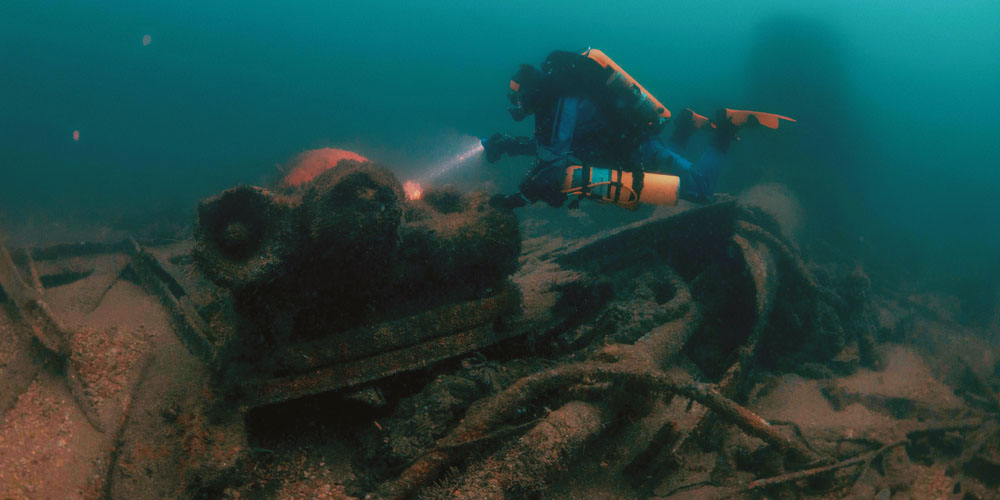
2. MV Dallas City
In 1940, MV Dallas City was travelling in convoy OA178, which was bombed as she passed Portland Bill. The convoy has become infamous as it sustained substantial losses: five out of 53 ships were lost and 11 substantially damaged, due to attacks from both bombers and the new German weapon, the E-boat (aka Schnellboot). Following these losses, a change in British strategy kept larger ocean-going ships away from the channel, sending them north around Scotland instead.
The Dallas City was hit at least three times, shot at and involved in a collision. All this caused multiple fires in the 7,400 tonnes of sulphate of ammonia that she was carrying. Disabled and with fumes permeating the vessel, the captain ordered an evacuation and all hands left the vessel safely. Left to the mercy of the sea, and well alight, all expected her to sink quickly. Hence the original reported position was 10 miles south of Portland Bill, but she must have drifted quite a distance and eventually sank 22 miles from St Catherine’s Point, to the south of the Isle of Wight.
In 2016, we dived an unknown wreck in 60m, with the aim of identifying it. There was some prior investigation suggesting that this might be the Dallas City, hence there were specific tasks to help identify her. Our first dive was in mid-October and while the surface conditions were good, underwater the visibility was only about three to four metres. As with most dives on new wrecks, the shot was positioned by the highest, most distinct part. This is usually the engine or boiler, and the Dallas City was no exception.
There were, in fact, no conventional boilers to be seen; but a distinctive, massive two-stroke, four-cycle Doxford oil engine and a vertical Cochran boiler, run off the exhaust gases and used for auxiliary steam. As the visibility was so poor, only a few shots of the engine, and possibly the boiler were taken. Other than that, there seemed to be a lot of wreckage spread over the seabed. These photos were shared with engine experts who identified this as the level two-valve maintenance rack, port side, on a Doxford engine, which was fairly unique.
Subsequent dives, in much better viz, have found that along with the engine and upright Cochran boiler, the stern is on its port side with an impressive steering quadrant, propeller and rudder. You will see from the photo of the solid bronze flywheel, weighing nearly two tonnes, that this is a massive engine.
At 60m this is a serious dive, however, the decompression time is a small price to pay after diving on a shipwreck with lots still to reveal alongside the impressive marine life, with congers in most holes and some even seen free-swimming.
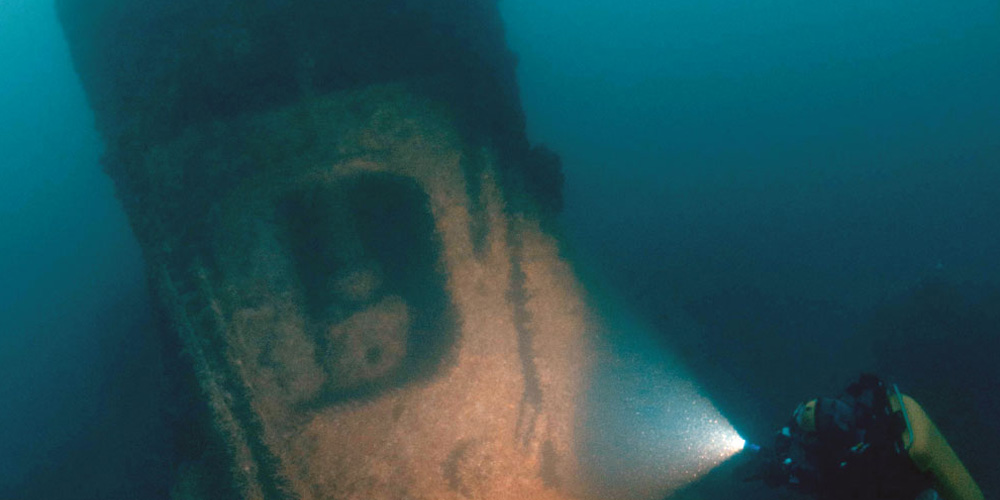
3. SS Saxmundham
In November 1888, the Saxmundham was heading from the Tyne to Ancona, Italy, full of coke and coal, when she was in collision with the barque Nor. The Saxmundham was badly damaged and sank within 10 minutes. Tragically, 12 of the crew lost their lives due to the speed of sinking.
Once located – a very difficult task as the collision took place offshore, at night – the wreck was identified by details from the steering gear. A tour of the Saxmundham usually begins on the engine, as this is the high point. The massive two-cylinder compound engine is eight metres high on a sandy seabed, with usually very good viz. Once you have investigated the con rods, valves and engine mechanism you will find the propeller shaft, still with the tunnel in place. A swim along brings you to a sandy seabed at around 60m and this marks the end of the wreck. Turning around you can look back and see the prop shaft, engine and boilers.
Going forward again, there is another opportunity to look around the twin boilers. In the boilers, and almost every other hole, you’ll see congers waiting for one of the numerous bib to come close and become lunch. Further on there is a smaller, upright donkey boiler. Looking to the starboard side, as you move forward, there is a rocky reef that sometimes is confused with the wreck. Near the reef, the side of the hull is clearly visible and here you’ll see a row of wooden deadeyes from the rigging.
The bow itself is very confusing as it is broken off and sits pointing upright at 90° to the line of the hull. This shows the force of the impact with the seabed during the wrecking. Still on the bow is the main winch and just to the port side, there are two anchors on top of each other.
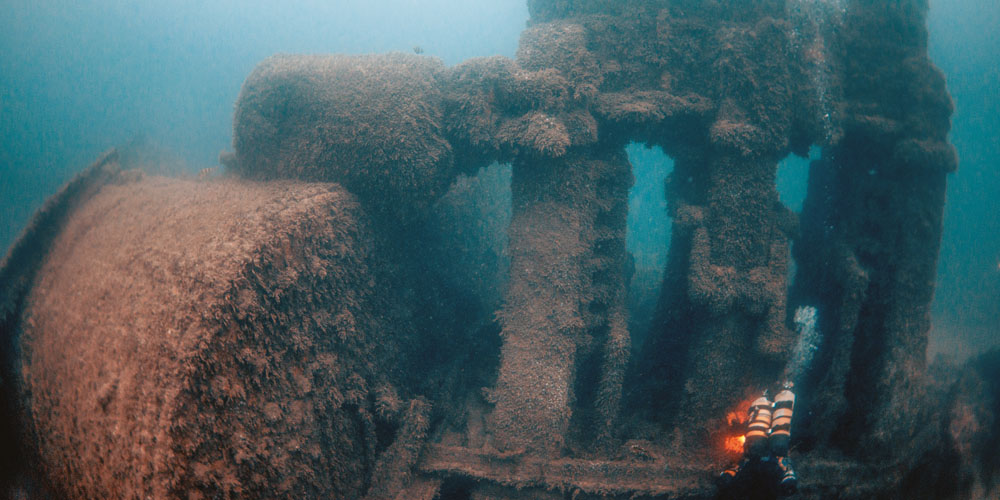
4. SMS Nurnberg
Following the 100th anniversary of the scuttling of the German High Seas Fleet in Scapa Flow in 2019, it would be remiss not to cover the southernmost diveable wreck from the Fleet. This Konig-class light cruiser was the second to be named Nurnberg; the first was sunk by the British during the Battle of the Falkland Islands in 1914. The new Nurnberg, commissioned in 1917, saw minimal action in the Baltic before the ceasefire. She was interned in Scapa Flow but was not successfully scuttled in the mass sinking – instead she was beached by the British. By 1920, she had been patched up, refloated, towed to Portsmouth and begun life as a target vessel.
Nurnberg is a 65m dive (making her one of the deepest diveable Scapa wrecks alongside the much deeper SMS Baden at around 170m). She lies more than 30 miles south of the Isle of Wight. On the wreck of a light cruiser, you can swim from end to end in a single dive without massive decompression penalty. This is a very different dive to the light cruisers of Scapa. Although the Nurnberg is upright she is quite broken, largely due to the amount of ordnance that the British tested on her armour plating. Finally, in July 1922, Nurnberg took more than 30 shells from HMS Repulse, nine hitting below the waterline. This onslaught proved definitive.
The bow is impressive and there is an anchor to port. You can see the winch capstans, with all the mechanisms sitting proud. As you swim to the stern there are a number of four-and-a-half-inch guns lying on the wreckage, with turrets still in place. The small boilers and engine are easily accessible, with even more guns on the deck around the stern. As you swim around the small stern – rudders and props still in place – you get the impression this was a fast ship, not on the scale of the battleships. The seabed is littered with pieces of the Nurnberg so it’s always worth a swim over the debris field before heading home.
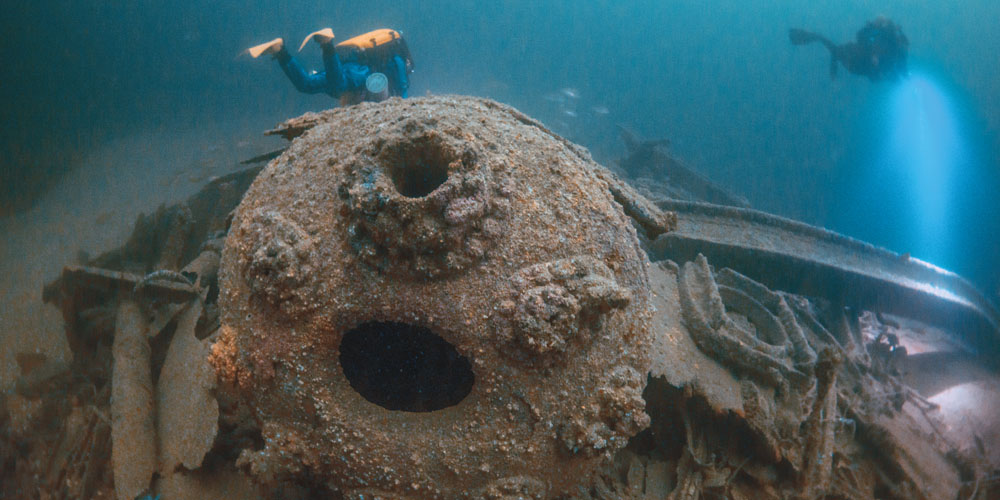
5. SS Ohio
The SS Ohio was 40 years old by 1918 and was kept in service to act as a general cargo vessel during the First World War. Cargo ships in ballast (empty) were instructed by the British Admiralty to take courses further away from the shore than laden ships, in a simple ploy to secure the goods that the convoys carried. With the valuable, full ships staying close to the coast and the less valuable, empty ships taking a course further offshore, German U-boats were targeting ships but not destroying any cargo.
In October that year, the Ohio was positioned around the middle of a convoy when a second convoy passed through on an opposite, collision course. They shouldn’t have crossed. Both convoys were showing minimal lights and the Ohio collided with Lady Plymouth, sinking quickly. Despite all 13 of the crew making it to the lifeboats, one stewardess died of pneumonia a few days later.
A 60m dive on the Ohio begins at the engine and boilers. Two boilers and a small donkey boiler are the high points. Just behind the boiler is the two-cylinder compound engine. The wreck has not been positively identified but the size, shape, engine configuration and its position make this the most likely ID. The engine is on its port side and still intact, enabling you to see the various pipes, con rods, valves and cylinders.
Following the propeller shaft across a debris field, the stern is marked by the propeller hub. There are no blades on the propeller, possibly indicating that she struck the seabed stern first or that the prop was spinning when she hit. Turning around and swimming back along the shaft, maybe on the opposite side, past the engine and boilers, you’ll come across a large winch. The winch position fits with the deck crane that the Ohio had and further supports the ID. Arriving at the bow you’ll see this is on its starboard side and quite intact, with both anchors still in place.
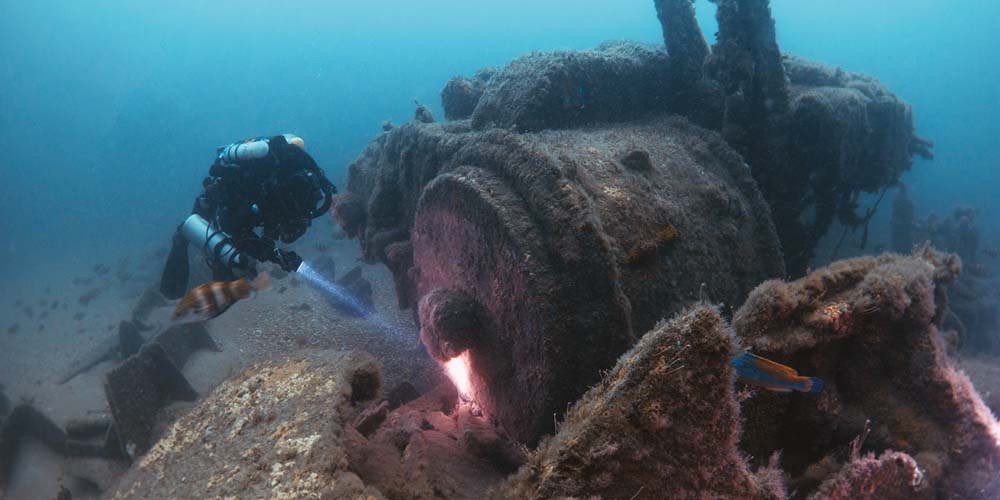
These five south-coast wrecks are an excellent introduction to the 60m trimix diving available on the south coast of England. We will explore five more in part two, in a future issue of SCUBA.
This UK Diving article was originally published in SCUBA magazine, Issue 101 April 2020.

 Author: Johno and Cathy de Lara | Posted 21 Nov 2020
Author: Johno and Cathy de Lara | Posted 21 Nov 2020



